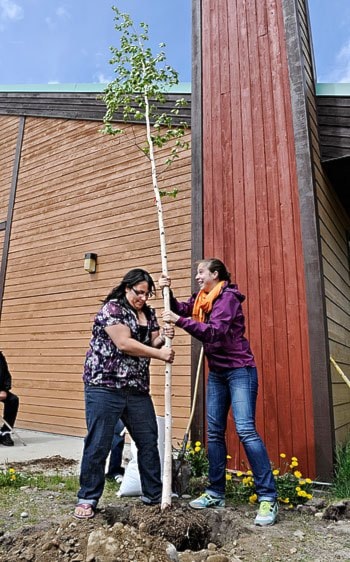There was no big banner nor huge crowd to ring in the National Day of Healing and Reconciliation on Monday.
Instead, a small circle of elders and residential school survivors sat at the Kwanlin Dun First Nation’s health centre eating lunch.
In between bites of stew and fresh fruit, they offered suggestions on what their community can do to heal and reconcile with its past of assimilation and abuse in government-sanctioned and church-run schools.
After lunch, two trees were planted outside the First Nation’s potlatch house.
“Originally, we wanted to plant enough trees to build a house,” said Jayla Rousseau-Thomas from the Yukon Aboriginal Women’s Council. “We thought that would be really symbolic of how households and families were torn apart by what happened after settlement in Yukon. Unfortunately it’s just really expensive to plant that many trees.”
Efforts to support former students and reverse the legacy residential schools have been stunted by a lack of funding all across Canada.
When funding for the national Aboriginal Healing Foundation wasn’t renewed in 2010, hundreds of programs and centres built by First Nations for their communities started to shut their doors.
Whitehorse’s Committee on Abuse in Residential Schools, or CAIRS, was one of them.
But this year’s National Day of Healing and Reconciliation marked the end of a three-year fight for CAIRS. By the time the executive director of the downtown drop-in centre arrived at the small gathering at the Kwanlin Dun health centre, the ink was dry on the agreement between CAIRS and Health Canada.
“We’ve established that we are here and we’re not going anywhere in the near future,” said Joanne Henry. “We are a needed organization and just by getting our funding, it shows us that.”
The agreement guarantees enough funding to run the centre and the programs it provides until March 31, 2013, said Henry.
“Each year, I’m guessing, we’ll have to put in our application form and apply for funding, but at least we’re here for another year,” she said.
The drop-in centre and carving studio sees at least 12 visitors every day, said Henry. Many times, those visitors are residential school survivors who just want a place to come, sit and hang out; other times they come in to work at the carving studio or get information on how to reach a counsellor. CAIRS also does work with the Truth and Reconciliation Commission. It goes into schools to tell first-hand stories about the history Canada has largely kept out the school curriculum and text books and it goes into communities, on request, to offer workshops and informal counselling, said Henry.
“Every day, we’re busy,” said Henry. “The whole thing with residential school isn’t going to go away right away.”
As more and more family members and children of survivors start to come through the doors at CAIRS, that statement couldn’t be more true.
The intergenerational effects are becoming much more visible, said Henry.
Rousseau-Thomas’ grandmother went to residential school. But it wasn’t until she started learning about the schools and what the students went through that Rousseau-Thomas found that out, she said.
“She never talked about it,” said Rousseau-Thomas about her grandmother. “But it’s very clear now. And it’s also been trickled down to me ... I have been affected.”
This is one of the reasons why it is important to include everyone in any programs offered to help former students, she said.
“If we have one blanket solution, there’s a lot of people that are going to be left out,” added Rousseau-Thomas. “Some turn to church, some turn to the bottle. We need to make sure we understand both of those personal approaches and accept both of those as people’s healing strategies. They might not be healthy, but that’s what they have and that’s what they use.”
And that’s part of the reason why CAIRS is as successful as it is.
“When you come to CAIRS, you don’t have to be anybody other than who you are,” said Henry. “There’s no pressure. You don’t have to come and be careful of what you say or how you act. You just come here and be who you are and it’s totally accepted. If you want to come and be on your own or if you want to come and work with somebody who has maybe gone through something similar to you, you can do that. It’s just a safe place.”
After the two white birch trees were planted outside the Kwanlin Dun potlatch house on Monday, strings of paper cut-out leaves were hung on their branches.
Everyone who came to the lunch and planting was invited to write down a wish they have for themselves or their community, as they continue to heal from residential schools.
“For me, the tree, and the seasons it goes through, symbolizes the culture of our communities and our families,” said Rousseau-Thomas. “If you think about a tree in the summer, when it’s big and full and beautiful, that was how we were when we had our strong cultures and traditions and values and we lived our traditional lives. And then when you think of fall, when things start to be less visible and go into a hibernation mode, as the time when first contact and settlement was made with our people. Winter is the unfortunate legacy of residential schools. And now, as we head into spring, and you think about a tree that’s starting to regrow, it’s as our people begin to rebuild - rebuild our culture and go back to the traditions that we once had.”
Contact Roxanne Stasyszyn at
roxannes@yukon-news.com
